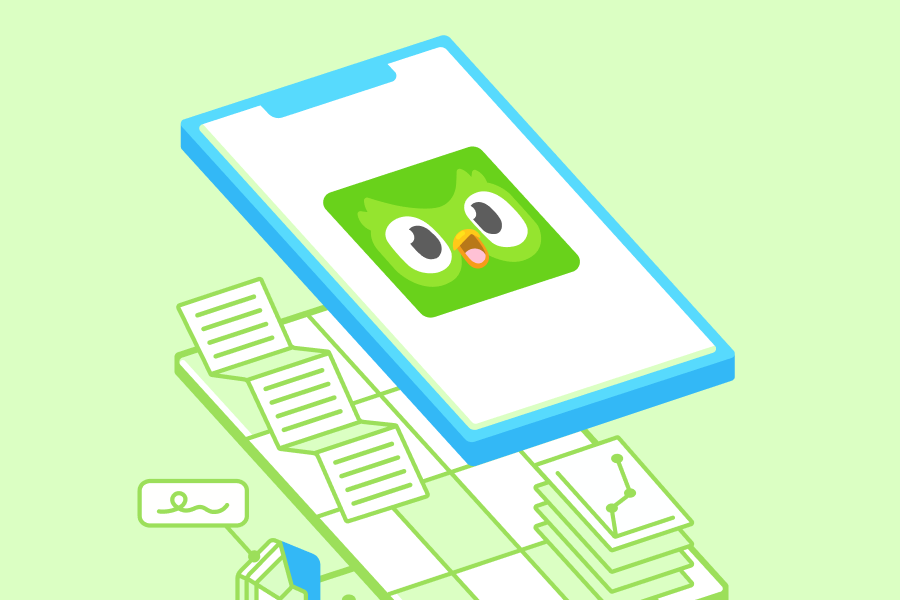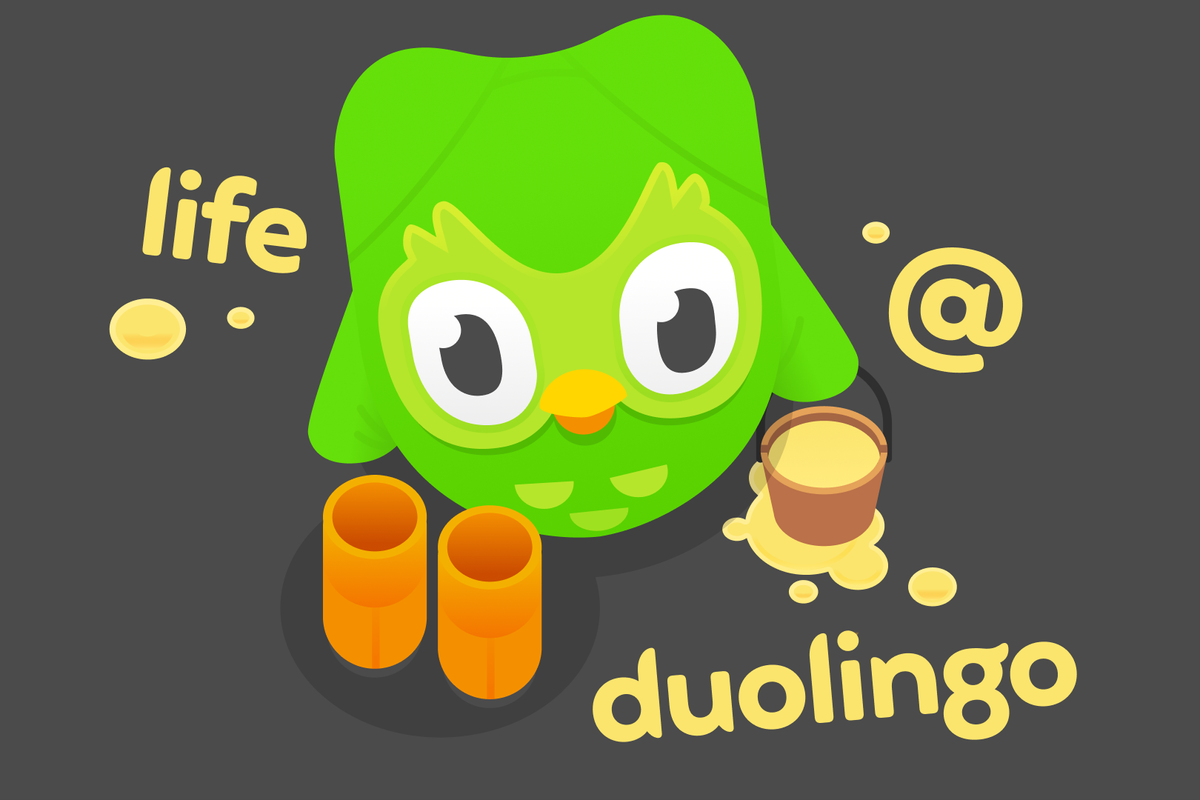Duolingo is the world's most downloaded education app, so naturally people are curious about how we do things here! There's a lot of work that goes into making learning free, fun, and effective for learners around the globe. Here are the answers to some of the most common questions about our app and courses. Read on for a behind-the-scenes look at how we think about learning and language teaching!
The most common questions we hear at Duolingo:
- Can Duolingo make me fluent?
- Are Duolingo courses developed by real people?
- Why does Duolingo have such weird sentences?
- Does Duolingo teach grammar?
- Why doesn’t Duolingo start with the ABCs?
- When will Duolingo add the language I want to study?
- Why does Duolingo teach made-up languages?
- Is Duolingo free?

Can Duolingo make me fluent?
Research shows that Duolingo is an effective way to learn a language! But the truth is that no single course, app, method, or book can help you reach all your language goals. Instead of measuring "fluency"—a vague goal that language experts and educators shy away from—we assess learners across four domains: speaking, writing, reading, and listening. Learners who completed the beginner content in our Spanish and French courses had reading and listening scores comparable to four semesters of university study! Our learners are also successfully acquiring speaking skills, with about half of learners achieving on-target speaking scores—or better! And we continue to evaluate our teaching methods and effectiveness for learners of all levels.
We also take into account learners' goals and needs at different proficiency levels, using the CEFR, an international language standard, as a guide. We use this combination of language skills and proficiency levels to create a suite of free learning tools; for example, DuoRadio episodes get learners practicing realistic listening scenarios, Stories teach learners of all levels reading and listening through conversational dialogues, and our award-winning Duolingo Podcast teaches intermediate learners about culture and spoken language around the world.
So, can Duolingo make you fluent? It's up to you and how you use it! To reach high proficiency in your new language, you'll need to dedicate serious study time, for a long time, so you need a plan you can stick with for the long haul. That's why Duolingo makes it easy and approachable to learn a new language and to start putting those skills to use right away!
Are Duolingo courses developed by real people?
Yes! Our learning designers and their teams of content creators include teaching experts, linguists, and native speakers—and many are all three in one! These experts work with advanced AI to create a personalized experience that can scale to millions of learners. Each Duolingo learner sees exercises in a totally unique order, selected just for them! Our algorithm studies each learner's responses to understand what material they've learned and what is still difficult and then adapts upcoming exercises to maximize effectiveness: The algorithm shows slightly harder exercises for things the learner knows well, and it provides more foundational exercises for topics that are more challenging.
We also use machine learning to help prioritize updates to our courses. This is especially important for managing the 200,000 learner-submitted reports we receive each day—by using technology, we can flag the reports most likely to be translations that we need to add to a course. This is a great way to make the most of our humans' expertise (teaching and language!) with one of machine learning's strengths (processing huge amounts of data).
Why does Duolingo have such weird sentences?
Silly sentences have a serious superpower… they’re memorable! And hidden inside that sentence about monkeys dancing on the highway is important grammatical information about verb conjugation, word order, and grammatical gender—rules that apply no matter how strange the sentence is. Read more about why we use silly sentences in our lessons.
Does Duolingo teach grammar?
Short answer: yes, Duolingo teaches grammar. But you won’t find many explicit grammar lessons in your course, and that’s because Duolingo uses implicit learning to help you understand and engage with new concepts. Instead of focusing on memorizing rules themselves—which can actually hinder learners’ ability to communicate—implicit learning gets learners *using* what they've seen in lessons to learn from mistakes and develop instincts for the new patterns and information. With implicit learning, you’re interacting with and using the language right from the start—and mistakes are a natural part of the learning process!
Why doesn’t Duolingo start with the ABCs?
If you’ve taken a language course in a classroom setting, you may remember learning the alphabet early on in instruction. The alphabet is important, sure, but it might not be the thing you want to use right away. You'll probably need to order food at a restaurant or introduce yourself instead!
Duolingo lessons take the communicative approach—which means we focus on the skills learners need in their daily lives, and we do so right from the beginning of the course. Things like the alphabet take the back seat here! (The approach is a little different for courses that teach non-Roman alphabets. Learn more about our reading tab, which you’ll find in our Japanese course!)
When will Duolingo add the language I want to study?
We're putting more resources into creating new content and learning tools for our existing courses, including more advanced content for learners all over the world. That can feel frustrating if you've been waiting to learn one of the thousands of languages Duolingo doesn't teach yet (did you know there are over 7,000 languages in the world today?). But we do offer more than 100 courses in over 40 languages, and our efforts to focus and prioritize mean that we’re improving and growing the languages we already teach.
Why does Duolingo teach made-up languages?
Duolingo teaches three constructed languages—Esperanto, High Valyrian from Game of Thrones, and Klingon from Star Trek—primarily for one reason: People want to study them! It also helps that these languages don't have to be aligned to proficiency standards, and so our teaching resources are spent on natural languages.
Instead, offering conlangs brings in a wider range of learners to the app. They use a small part of Duolingo's marketing and partnership resources, and by having more learners and subscribers in general, we can continue our mission of making (and keeping) all our language courses available to everyone for free.
Speaking of… is Duolingo free?
We see this question a lot, and the answer is: yes! Duolingo is a free language-learning platform, and every language and lesson is totally free! We do have two paid subscription tiers: premium Super Duolingo, which comes with perks like no ads and unlimited hearts, and Duolingo Max, which adds on advanced features powered by generative AI. The quality of learning tools and language education that you get on Duolingo's free version is just as effective—and fun!—as with a subscription.



